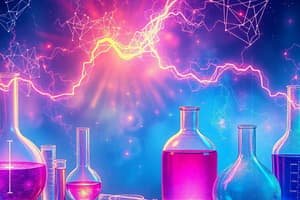Podcast
Questions and Answers
Which assessment task is worth the highest proportion of the total assessment?
Which assessment task is worth the highest proportion of the total assessment?
- Midterm exam
- Lab
- Final exam (correct)
- Class activates
Why don't we see diamonds in jewelry turning into graphite, even though the reaction happens?
Why don't we see diamonds in jewelry turning into graphite, even though the reaction happens?
- The reaction is not favorable
- The reaction is not spontaneous
- The reaction occurs too fast
- The reaction occurs too slow (correct)
What is the value of ΔG for the reaction diamond → graphite mentioned in the text?
What is the value of ΔG for the reaction diamond → graphite mentioned in the text?
- 2.9 kJ
- 0 kJ
- -2.9 kJ (correct)
- Unknown
What does thermodynamics tell us about reactions?
What does thermodynamics tell us about reactions?
Does a spontaneous reaction always occur fast?
Does a spontaneous reaction always occur fast?
What is the proportion of the total assessment for the midterm exam?
What is the proportion of the total assessment for the midterm exam?
What is the proportion of the total assessment for the final exam?
What is the proportion of the total assessment for the final exam?
Which assessment task is worth the lowest proportion of the total assessment?
Which assessment task is worth the lowest proportion of the total assessment?
What is the topic of the course CHEM402?
What is the topic of the course CHEM402?
Why does the reaction diamond → graphite occur very slowly?
Why does the reaction diamond → graphite occur very slowly?
Flashcards
Final Exam Weight
Final Exam Weight
The final exam contributes the most to the overall grade, accounting for 40% of the total assessment.
Diamond to Graphite Conversion
Diamond to Graphite Conversion
Despite diamond being the thermodynamically favored product, its transformation to graphite is practically unobservable because the reaction proceeds incredibly slowly due to a very high activation energy.
ΔG of Diamond to Graphite
ΔG of Diamond to Graphite
The change in Gibbs Free Energy (ΔG) for the conversion of diamond to graphite is -2.9 kJ, which is a negative value, indicating that the reaction is thermodynamically favorable, meaning it will spontaneously proceed towards graphite.
Thermodynamics: Reaction Insights
Thermodynamics: Reaction Insights
Signup and view all the flashcards
Spontaneity vs. Rate
Spontaneity vs. Rate
Signup and view all the flashcards
Midterm Exam Weight
Midterm Exam Weight
Signup and view all the flashcards
Class Activity Weight
Class Activity Weight
Signup and view all the flashcards
CHEM402: Course Topic
CHEM402: Course Topic
Signup and view all the flashcards
Slow Diamond to Graphite Conversion
Slow Diamond to Graphite Conversion
Signup and view all the flashcards
Activation Energy of Diamond to Graphite
Activation Energy of Diamond to Graphite
Signup and view all the flashcards




